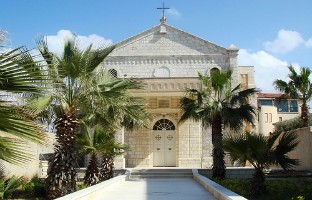New Christians in Israel

Anyone with a taste for sharp satire will enjoy the wickedly funny 2003 film James' Journey to Jerusalem, which uses the familiar device of a wide-eyed Candide figure to expose the foibles of contemporary society—in this case, the state of Israel.
For American viewers, one surprising feature of the film is the background of James himself. He is a devoted African Christian. Clearly, the idea of African Christians in Israel is not considered even slightly strange in the film, and a moving scene shows James gathering with other immigrant believers in a crowded church. He moves in a transplanted African world that differs little from the better-known Christian expatriate communities of Europe.
Read our latest issue or browse back issues.
Recent events in Iraq and elsewhere have made us familiar with the idea of the Middle East's Christian population as a threatened species. Yet beside the real dangers of violence and persecution faced by ancient churches, we also see startling signs of new Christian growth across the region. So many African and Asian immigrants have flocked there to find work that Christians make up 5 to 10 percent of the populations of the Arab Gulf states, and even Saudi Arabia.
In Israel too, substantial new migration has ensured that Christians have not disappeared from the region's religious mix. Traditionally, Palestine's Arab population had a sizable Christian minority, perhaps 20 percent of the whole in 1900. Continual emigration steadily reduced that share over the following century, and Muslim Palestinians had substantially higher birth rates. Recent Western travelers have bemoaned the shrinking Christian presence in the oldest centers of faith, even in towns like Nazareth and Bethlehem, where within a few years Christians might become as scarce as they are in Baghdad.
But Christian numbers have begun to swell again, drawing this time on wholly different sources. The fall of the Soviet Union was one major factor. As that empire declined, migration to Israel became common, so that today some 1.3 million Israelis speak Russian. Though most migrants claimed Jewish status in order to enter Israel, their Judaism was often tenuous. It is an open secret that for many who identified with any religion at all, it was Christianity—mainly Orthodox but also Baptist and Pentecostal.
Israel's Russian Christian community today is perhaps 80,000 strong, and the nation's Orthodox churches overflow at festivals like Christmas. The Israeli state has had to be flexible to accommodate those new citizens to the point of printing Hebrew New Testaments for the use of Christian recruits when they take their oaths of allegiance on entering the armed forces.
Other Christians have arrived from African or Asian countries, drawn by Israel's prosperity and its need for labor. The exact numbers are uncertain, because so many of the new arrivals do not have legal status, usually overstaying pilgrim or tourist visas, and they engage in a constant game of cat and mouse with immigration authorities. In 2000, Israel might have had 15,000 African immigrants, but that number fluctuated following draconian raids over the following years. Israel's Filipino community, almost wholly Catholic, is 40,000 strong.
Immigrant churches flourish in Israel, partly because poor newcomers commonly turn to their religious institutions for mutual aid and support and to find legal services and language lessons. More fundamentally, these communities stem from countries where religious observance is a familiar and expected part of life. By 2000, Israel had some 40 African churches, most of them highly charismatic in tone.
As I have suggested, the numerical strength of Christianity in Israel is none too clear because of the difficulties associated with illegal immigration and the mixed religious identity of some notionally Jewish migrants. The CIA Factbook puts the number of Christians in Israel at 150,000, not counting the occupied territories. Other estimates point to a larger number, taking into account Palestinian Arabs, Russians, Filipinos and Africans, including all the crypto-Christians and Messianic Jews. The real number is probably close to 200,000, or 2.5 percent of the population. That does not take account of at least 150,000 more Christians on the occupied West Bank.
Naturally enough, given the tortuous history of Jewish-Christian relations, those growing Christian numbers alarm reactionary Israeli politicians, and the resulting rhetoric can be harsh. To the horror of Israeli authorities and media, ultra-Orthodox Jewish fanatics regularly spit at Christian clergy in Jerusalem's streets. More commonly though, Jewish Israelis accept the fact of religious diversity, provided that those other believers accept and defend the state.
For Western Christians, the modern Israeli story is multiply interesting for what it reveals about the changing fortunes of a religion and the unsuspected ways in which the faith can survive even in the most discouraging settings. And just how long has it been since Hebrew was the native language of a Christian community?






